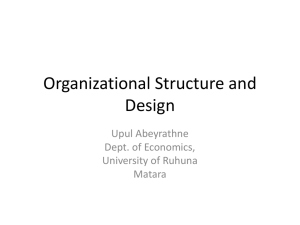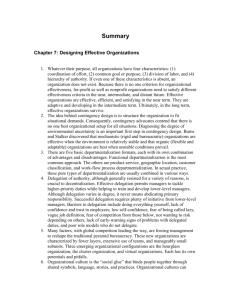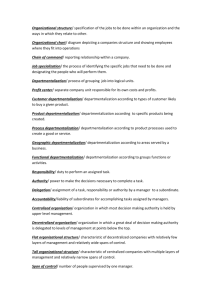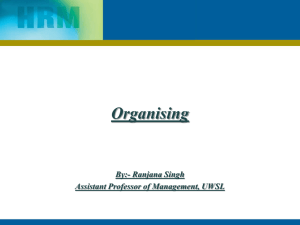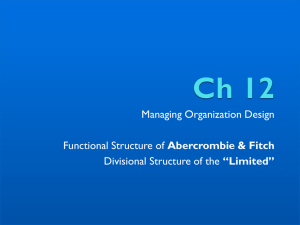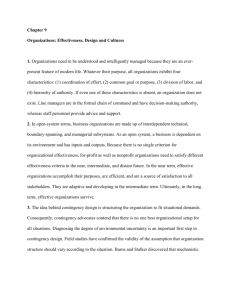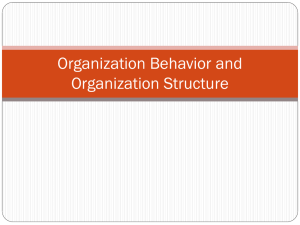LECTURE OUTLINE AND LECTURE NOTES
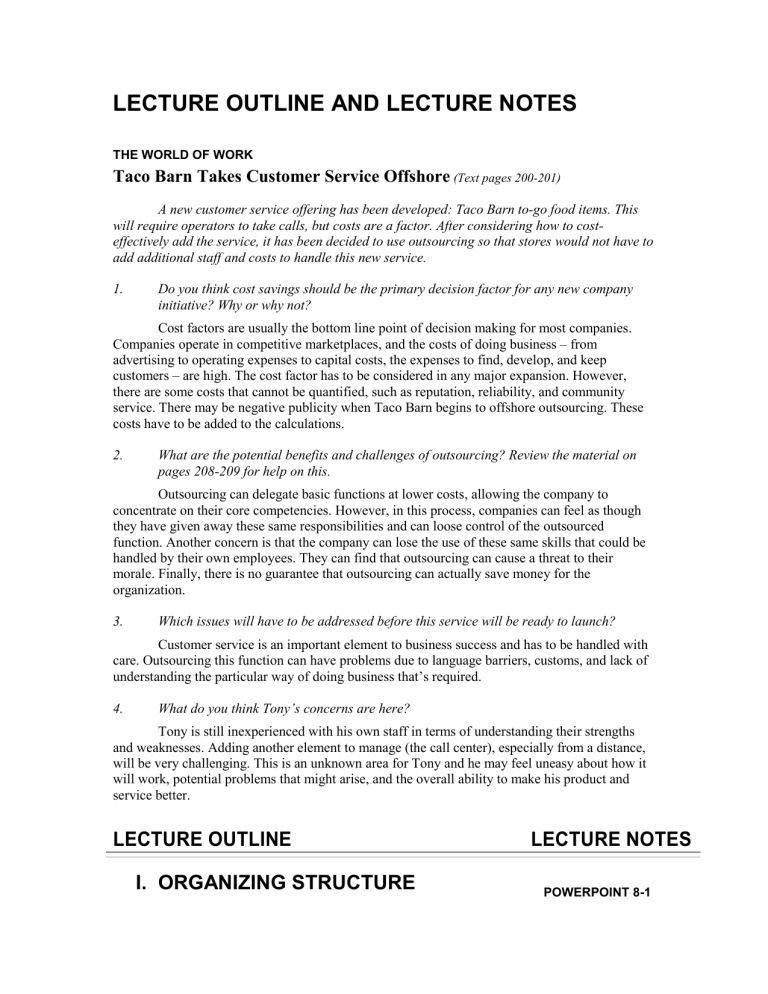
LECTURE OUTLINE AND LECTURE NOTES
THE WORLD OF WORK
Taco Barn Takes Customer Service Offshore
(Text pages 200-201)
A new customer service offering has been developed: Taco Barn to-go food items. This will require operators to take calls, but costs are a factor. After considering how to costeffectively add the service, it has been decided to use outsourcing so that stores would not have to add additional staff and costs to handle this new service.
1. Do you think cost savings should be the primary decision factor for any new company initiative? Why or why not?
Cost factors are usually the bottom line point of decision making for most companies.
Companies operate in competitive marketplaces, and the costs of doing business – from advertising to operating expenses to capital costs, the expenses to find, develop, and keep customers – are high. The cost factor has to be considered in any major expansion. However, there are some costs that cannot be quantified, such as reputation, reliability, and community service. There may be negative publicity when Taco Barn begins to offshore outsourcing. These costs have to be added to the calculations.
2. What are the potential benefits and challenges of outsourcing? Review the material on pages 208-209 for help on this.
Outsourcing can delegate basic functions at lower costs, allowing the company to concentrate on their core competencies. However, in this process, companies can feel as though they have given away these same responsibilities and can loose control of the outsourced function. Another concern is that the company can lose the use of these same skills that could be handled by their own employees. They can find that outsourcing can cause a threat to their morale. Finally, there is no guarantee that outsourcing can actually save money for the organization.
3. Which issues will have to be addressed before this service will be ready to launch?
Customer service is an important element to business success and has to be handled with care. Outsourcing this function can have problems due to language barriers, customs, and lack of understanding the particular way of doing business that’s required.
4. What do you think Tony’s concerns are here?
Tony is still inexperienced with his own staff in terms of understanding their strengths and weaknesses. Adding another element to manage (the call center), especially from a distance, will be very challenging. This is an unknown area for Tony and he may feel uneasy about how it will work, potential problems that might arise, and the overall ability to make his product and service better.
LECTURE OUTLINE LECTURE NOTES
I. ORGANIZING STRUCTURE
POWERPOINT 8-1
LECTURE OUTLINE LECTURE NOTES
A. ORGANIZATIONAL STRUCTURE is the framework that defines the boundaries of the formal organization and within which the organization operates.
B. It reflects:
1. how groups compete for resources
2. where responsibilities for profits and performance lie
3. how information is transmitted
4. how decisions are made
C. An appropriate organization structure encourages good performance.
II. ORGANIZING GROWTH STAGES
A. In the craft or family stage , there are no formal policies, objectives, or structure.
B. During the entrepreneurial stage , the organization grows at a fast rate first, then at a slower rate.
C. The third stage is the growth stage .
1. By the time the entrepreneur has been replaced by a professional manager.
2. The organization develops written policies, procedures, and plans.
D. During the transition from craft stage into the entrepreneurial stage, it is critical to establish an appropriate structure.
Chapter Title
(Refers to text pages 200)
POWERPOINT 8-2
Learning Objectives
(Refers to text page 201)
TEXT FIGURE 8.1
Organization Growth and
Change (Text page 202)
POWERPOINT 8-3
Organizing Structure
(Refers to text pages 202-
203)
III. ORGANIZING CHARTS
►
LEARNING OBJECTIVE 1
Explain the purpose of an organization chart.
(Text pages 202-203)
A. An organization chart uses a series of boxes connected with one or more lines to
LECTURE OUTLINE graphically represent the organization’s structure.
B. The chart gives an overall picture of how the entire organization fits together.
LECTURE NOTES
IV. FACTORS AFFECTING
ORGANIZATION
►
LEARNING OBJECTIVE 2
Describe factors and changes that affect an organization’s structure.
(Text pages 203-
208)
A. Strategy
1. An appropriate structure helps the organization reach strategic goals.
2. The organization’s structure clarifies strategy through delegation of authority and responsibility.
3. Al fred D. Chandler’s study of organization strategy describes a repeating pattern. a. Changing strategy led to decline in performance, then revised structure, and improvement. b. Chandler concluded that changes in strategy ultimately led to changes in the organization’s structure.
4. There are many variables to consider matching structure to strategy.
B. Size
1. The most common measures of organization size are sales volume and number of employees.
2. Small organizations tend to be less specialized.
POWERPOINT 8-4
Factors Affecting
Organization
(Refers to text pages 203-
204)
POWERPOINT 8-5
Factors Affecting
Organization (continued)
(Refers to text pages 204-
205)
LECTURE OUTLINE LECTURE NOTES
3. Larger organizations tend to be more specialized.
C. Environment
1. A study by Tom Burns and G. M.
Stalker found a relationship between organization and characteristics of the external environment. a. MECHANISTIC SYSTEMS are characterized by: i. a rigid definition of functional duties ii. precise job descriptions iii. fixed authority and responsibility iv. a well-developed organizational hierarchy b. ORGANIC SYSTEMS are characterized by: i. less formal job descriptions ii. greater emphasis on adaptability iii. more participation iv. less fixed authority
2. They found that successful firms in stable and established industries tend to be mechanistic in structure.
3. Successful firms in dynamic industries tend to be organic.
4. Another study by Paul Lawrence and
Jay Lorsch reached similar conclusions. a. Firms operating in a dynamic environment needed a relatively flexible structure.
TEXT FIGURE 8.2
Structural Differences
Between Mechanistic and
Organic Systems (Text page
205)
LECTURE OUTLINE b. Firms in a stable environment needed a more rigid structure. c. Firms operating in an intermediate environment needed a structure somewhere between.
LECTURE NOTES
ETHICAL MANAGEMENT (Text page 205)
At the height of his powers as the chairman and CEO of the Walt Disney Company, Michael
Eisner’s activities were, in theory at least, overseen by a board of directors reported to be independent, objective, and committed to ensuring that Eisner ran the company in an ethical and professional manner. In reality, Eisner had personal and professional relationships with many of the board members:
What’s wrong with this picture? What should the Disney Company have done to ensure that the board could fulfill its obligation to shareholders?
The board of directors of a public corporation is elected by the stockholders. Most corporations hold annual meetings in which shareholders can voice concerns about the direction of the organization.
For years, Disney’s stockholders condoned the practice of hiring directors with personal relationships, or at least did not object. In Disney’s case, the situation was complicated by a deep and bitter riff between the board and members of the Disney family.
A large proportion of Disney’s stock is owned by institutional investors – pensions and investment firms. Their directors should also be held responsible for not questioning the CEO’s actions.
D. Organization and Technology
1. In her 1950s study, Joan Woodward classified manufacturing firms along a scale of “technical complexity” involving three modes of production: a. unit or small-batch production b. large-batch or mass production c. continuous flow or process production
2. Woodard used several organizational variables to categorize firms:
3. She found: a. The number of levels in an organization increased as technical complexity increase. b. Organic systems were at both
POWERPOINT 8-6
Factors Affecting
Organization (continued)
(Refers to text pages 206-
208)
LECTURE OUTLINE ends of the continuum. c. Mechanic systems were found in the middle ranges.
4. In another study, Edward Harvey grouped firms along a continuum from technical “diffuseness” to technical
“specificity.”
5. The consensus of these studies was that a relationship exists between organizational technology and organization structure.
PROGRESS CHECK QUESTIONS (Text page 208)
1.
What is an organization chart?
2.
Explain the stages an organization goes through as it grows and matures
3.
What are the four most important factors affecting organization structure?
4.
Explain the differences between mechanistic and organic organizational systems.
LECTURE NOTES
TEXT FIGURE 8.3
Partial Organizational
Chart for IWT (Text page
208)
CASE INCIDENT 8.1
Who Dropped the Ball?
(Text pages 206-208)
Industrial Water Treatment (IWT) has developed a new product (Kelate) that is ten times more effective in treating scale build-up in boilers. With the increase in business, more service managers are needed. With the added staffing, each district office has to reorganize its operation to accommodate the workload. After the reorganization, a customer complains about a service engineer not showing up for a service call and the lack of follow-up to correct the problem. Bill Marlowe, the district manager for the southeast district, has to figure out what went wrong and why more complaints are being made since the reorganization.
1. How has IWT’s structure changed?
The organizational structure, once simple, has become much more layered because of the increased staffing and work loads. The previous organizational structure was a simple line structure where the chief engineer and the two engineer supervisors reported back to the district manager. The new structure become horizontal by having two groups below the district manager (chief engineer and the manager of operations), each with the responsibility of supervising engineer supervisors but dividing how the work would be assigned and handled based on the technical nature of the problem. This new structure becomes more complicated when a decision has to be made as to what part of the structure must handle problems. In the process new lines of communications must be established to assure customer needs are being handled with the same level of urgency and satisfaction as found in the past.
LECTURE OUTLINE LECTURE NOTES
2. What problems does Bill Marlowe face?
Bill is trying to assure customers that IWT is the same company and can still handle its business and perform at the same expected level it has in the past. However, Bill knows how much more complicated this is and has a more difficult job in making sure customers are getting responded to in a timely manner. Bill has to find out where the miscommunications occurred, and more importantly, how to pull things together so that the customer service reputation for his company does not suffer. His job is finding where the breakdowns occur and using his authority to get the customer problems handled.
Because of the reorganization, this is more difficult than in the past.
3. Are the problems related to the way IWT is organized, or are they related to the employees?
Under the new organizational structure, the four group leaders report to both Ed Jones, Chief
Engineer, and to Dick Welsh, Manager of Operations. This violates the unity of command principle. The service engineers don’t know who is responsible for assigning work. Neither Ed nor Dick has taken responsibility for handling the problem.
Other problems involve the managers themselves. Ed and Dick do not appear to communicate effectively. Dick doesn’t keep up with messages, even though it is his responsibility to handle work assignments.
4. How could these problems be resolved?
The reorganization should be reconsidered. Perhaps two group leaders could be assigned to Ed and two to Dick, providing unity of command and a clear chain of command.
The company also needs to modernize its communication system, also. Message slips on crowded desks have no place in the workplace of intranets and Blackberries. An email from Wes to all persons affected would have started the problem solving long before it reached Bill Marlowe.
V. CHANGES AFFECTING
ORGANIZATION STRUCTURE
A. Advances in communication technology have also changed the structure of the organization.
B. OUTSOURCING is the practice of subcontracting certain work functions to an outside organization.
1. Work functions frequently outsourced are accounting, finance, human relations, and information technology.
2. Outsourcing is growing rapidly.
3. Potential benefits include: a. emphasizing the organization’s
TEXT FIGURE 8.4
Variables Affecting
Appropriate Organization
Structure (Text page 210)
POWERPOINT 8-7
Changes Affecting
Organization Structure
(Refers to text pages 208-
209)
LECTURE LINK 8-1
Outsourcing Tutoring
One unique brand of offshore outsourcing is linking teachers in India with U.S. students who need tutoring.
See complete lecture link on page 8.
Ошибка! Закладка
LECTURE OUTLINE core competencies b. reducing operating costs c. accessing top talent and technology d. reducing personnel headaches e. improving resource allocation
4. Drawbacks include: a. loss of a large number of jobs to other countries b. loss of control c. loss of in-house skills d. threat to the morale of the workforce e. no guarantee that it will save money
LECTURE NOTES не определена.
of this manual.
BONUS CASE 8-1
IBM: Two-Way
Outsourcing
Unable to compete against competitors such as Dell,
IBM outsourced manufacturing overseas. It also has partnered with former competitors to do a bit or reverse outsourcing at home. See complete case, discussion questions, and suggested answers on page
8.
Ошибка! Закладка не определена.
of this manual.
VI. A CONTINGENCY APPROACH
►
LEARNING OBJECTIVE 3
Define a contingency approach.
(Text page 210)
A. According to the CONTINGENCY
APPROACH to organizing, there is no one best way to organize.
B. The values discussed above should be analyzed when choosing the appropriate organization structure.
POWERPOINT 8-8
A Contingency Approach
(Refers to text page 210)
TEXT REFERENCE
Study Skills Box: Write
Your Own Ticket!
The skill that can advance your career is exceptional writing capability. (Box in text on page 210.) An additional exercise and discussion is available in this chapter on page 8.
Ошибка!
Закладка не определена.Ошибка!
Источник ссылки не найден.Ошибка!
Источник ссылки не найден.
.
VII. DEPARTMENTALIZATION
►
LEARNING OBJECTIVE 4
Identify the different types of
POWERPOINT 8-9
Departmentalization
(Refers to text pages 210-
LECTURE OUTLINE LECTURE NOTES departmentalization.
(Text pages 210-214)
A. DEPARTMENTALIZATION involves grouping jobs into related work units.
B. Work Functions
1. FUNCTIONAL
DEPARTMENTALIZATION occurs when organization units are defined by the nature of the work.
2. Most organizations have four basic functions: production, marketing, finance, and human resources. a. Production refers to the actual creation of something of value. b. Marketing involves product planning, product pricing, and distribution. c. All organizations must provide the financial structure. d. The human resource function is responsible for securing and de veloping the organization’s people.
3. Each of these basic functions can be broken down even further.
4. The primary advantage of functional departmentalization is that it allows for specialization, resulting in: a. efficient use of equipment b. potential economies of scale c. ease of coordination within the function itself
5. Negative effects a. Group members can develop more loyalty to the group’s goals
212)
BONUS INTERNET
EXERCISE 8-1
How Do Organizations
Group Activities?
This Internet exercise asks students to search the websites of several organizations to identify the primary method of departmentalization. See complete exercise on page
8.
Ошибка! Закладка не определена.
of this manual.
CRITICAL THINKING
EXERCISE 8-1
Building an Organization
Chart
This exercise gives a list of employees and asks students to create an organization chart showing a possible chain of command. See complete exercise on page
8.
Ошибка! Закладка не определена.
of this manual.
CRITICAL THINKING
EXERCISE 8-2
Designing
Departmentalization
This exercise asks students to design an organization structure for a manufacturing firm. See complete exercise on page 8.
Ошибка!
Закладка не определена.
of this manual.
TEXT FIGURE 8.5
Functional
LECTURE OUTLINE LECTURE NOTES that to the organiza tion’s goals. b. Conflict can develop when different departments strive for different goals. c. Employees have a restricted view of the organization. d. A multidisciplinary approach may give better results.
C. Product
1. Under PRODUCT
DEPARTMENTALIZATION all the activities needed to produce and market a product or service are usually under a single manager.
2. Advantages: a. helps employees identify with a particular product c. provides opportunities for training
D.
3. b. helps manage each product as a distinct profit center managers in a broad range of activities
Disadvantages: a. Departments may become overly competitive. b. Facilities and equipment can be duplicated.
4. Product departmentalization works best in large, multi-product organizations.
Geographic
1. GEOGRAPHIC
DEPARTMENTALIZATION is most likely to occur in
Departmentalization (Text page 212)
POWERPOINT 8-10
Departmentalization
(continued) (Refers to text
pages 212-213)
TEXT FIGURE 8.6
Product
Departmentalization (Text page 212)
LECTURE OUTLINE LECTURE NOTES organizations that maintain physically isolated and independent operations.
2. More local employees are used, which can create customer goodwill.
3. However, having too many locations can be costly.
E. Customer
1. CUSTOMER
DEPARTMENTALIZATION is based on division by customers served.
2. Example: retail customers and industrial customers.
3. This type has the same advantages and disadvantages as product departmentalization.
F. Other Types
1. If success is measured by number of employees, departmentalization by simple numbers can be used.
2. The organization can also use: a. departmentalization by process or equipment b. departmentalization by time or shift
G Hybrid Departmentalization
1. As an organization gets large, it adds levels of departmentalization.
2. HYBRID DEPARTMENTALIZATION occurs when an organization simultaneously uses more than one type of departmentalization.
PROGRESS CHECK QUESTIONS (Text page 214)
5.
What are the potential benefits and drawbacks of outsourcing?
TEXT FIGURE 8.7
Customer
Departmentalization (Text page 213)
POWERPOINT 8-11
Departmentalization
(continued) (Refers to text
pages 213-214)
TEXT FIGURE 8.8
Possible
Departmentalization Mixes for a Sales
Organization (Text page
LECTURE OUTLINE
6.
Explain the contingency (situational) approach to organizing.
7.
Explain the process of departmentalization.
8.
Define the terms geographic, customer, and hybrid departmentalization.
LECTURE NOTES
214)
VIII. TYPES OF ORGANIZATIONAL
STRUCTURE
►
LEARNING OBJECTIVE 5
Describe the different types of organizational structure, including a virtual organization.
(Text pages 215-220)
A. Line Structure
1. In a line organization, authority originates at the top and moves downward.
2. All managers perform line functions, or functions that contribute directly to company profits.
3. In the LINE STRUCTURE the work of all organizational units is directly involved in producing and marketing the organiza tion’s goods or services.
4. Rapid decision making is possible through the chain of command.
5. However, managers may be forced to perform too broad a range of duties.
6. The line structure usually exists in small organizations.
B. Line and Staff Structure
1. The addition of staff specialists to a line-structured organization creates a
LINE AND STAFF STRUCTURE . a. STAFF FUNCTIONS are advisory and supportive in nature.
POWERPOINT 8-12
Types of Organizational
Structures (Refers to text
page 215)
TEXT FIGURE 8.9
A Simplified Line
Structure (Text page 215)
TEXT FIGURE 8.10
A Simplified Line and Staff
Structure (Text page 216)
POWERPOINT 8-13
Types of Organizational
Structures (continued)
(Refers to text pages 215-
216)
LECTURE OUTLINE LECTURE NOTES b. LINE FUNCTIONS are directly involved in producing and marketing the organization’s goods or services.
2. Staff people are usually specialists in one field, and their authority is limited to making recommendations to line personnel.
3. Example: research and development
4. The line and staff organization can create conflict. a. Staff specialists resent that they have no real authority. b. Line managers are often reluctant to listen to staff advice.
C. Matrix Structure
1. The matrix (often called project ) form of organization is a way of forming project teams within the traditional line and staff organization. a. A project is “a combination of human and nonhuman resources pulled together in a temporary organization to achieve a specified purpose. b. This structure was developed to deal with the temporary nature of projects.
2. Under the MATRIX STRUCTURE , those working on a project are officially assigned to the project and to their original or base departments. a. A manager is given the authority and responsibility to meet the
LECTURE LINK 8-2
Bureaucracy Is Bad for
Our Health
One cause of workplace stress is the traditional bureaucratic, top-down organization structure. See complete lecture link on page
8.
Ошибка! Закладка не определена.
of this manual.
POWERPOINT 8-14
Types of Organizational
Structures (continued)
(Refers to text pages 216-
218)
LECTURE LINK 8-3
The Manhattan Project
To build the world’s first atomic bomb, the military turned to General Leslie
Groves, known for his administrative ability, organizational skill, and decisiveness. See complete lecture link on page
8.
Ошибка! Закладка не определена.
of this manual.
TEXT FIGURE 8.11
LECTURE OUTLINE LECTURE NOTES project objectives. b. Next, the necessary personnel from functional departments are assigned. c. A horizontal-line organization develops within the vertical-line structure. d. When the project or their individual work on it is done, they return to their functional departments.
3. Advantages a. The mix of people and resources can readily be changed as project needs change. b. Project members can easily move back into the functional organizations once the project is over. c. Interdepartmental cooperation can develop.
4. Problems a. It can violate the principle of unity of command. b. A role conflict can develop if authority is not clearly delineated between functional managers c. The functional manager has little opportunity to observe individual employees. d. It can put undue stress on communication networks.
D. Horizontal Structure
1. HORIZONTAL STRUCTURE (also
Illustrative Matrix
Structure (Text page 217)
TEXT REFERENCE
Career Management Box:
Assessing Strengths and
Weaknesses
Identifying your strengths and weaknesses makes you a more productive worker.
(Box in text on page 218.)
An additional exercise and discussion is available in this chapter on page 8.
Ошибка!
Закладка не определена.Ошибка!
Источник ссылки не найден.Ошибка!
Источник ссылки не найден.
.
LECTURE OUTLINE LECTURE NOTES called team structure ) consists of two core groups: a. senior management who are responsible for strategic decisions and policies b. empowered employees working together in different process teams
2. Characteristics: a. The organization is built around three to five core processes, each with a champion. b. The hierarchy is flattened to reduce supervision. c. Teams manage everything. d. Customers drive performance. e. Team performance is rewarded. f. Customer contact is maximized with employees. g. Emphasis is on informing and training all employees.
3. Information is processed at the local level.
4. Additional advantages: a. increased efficiency b. improved work culture and morale c. more satisfied customers
PROGRESS CHECK QUESTIONS (Text page 219)
9.
How is a line and staff structure created?
10.
Explain how the matrix organization structure works.
11.
What is the major advantage of the matrix structure?
12.
What are the seven characteristics of the horizontal organization structure?
TEXT FIGURE 8.12
Horizontal Structure
(Text page 218)
POWERPOINT 8-15
Types of Organizational
Structures (continued)
(Refers to text pages 218-
221)
BONUS CASE 8-2
Making Teams Work in a
Changing Market
Two partners decided to abandon the traditional departmentalized structure and group their employees into account teams. See complete case, discussion questions, and suggested answers on page 8.
Ошибка!
Закладка не определена.
of this manual.
LECTURE OUTLINE
X. THE VIRTUAL ORGANIZATION
A. The VIRTUAL ORGANIZATION is one in which business partners and teams work together across geographical or organizational boundaries by means of information technology.
B. Three Common Types of Virtual
Organizations
1. A group of skilled individuals form a company by communicating by computer, phone, fax, and videoconference.
2. A group of companies, each of which specializes in a certain function, partner together.
3. One large company uses communication technology to outsource operations to partner companies.
C. Integrated computer and communication technology tie the contributors together.
D. Text Figure 8.14
shows the benefits and challenges of virtual organizations.
LECTURE NOTES
TEXT FIGURE 8.13
Virtual Organization
(Text page 220)
POWERPOINT 8-16
Trends in Organization
Structure (Refers to text pages 221-222)
TEXT FIGURE 8.14
Benefits and Challenges Of
Transitioning to a Virtual
Organization (Text page
221)
XI. TRENDS IN ORGANIZATION
STRUCTURE
A. Flat Versus Tall Organization Structures
1. A FLAT STRUCTURE has relatively few levels and relatively large spans of management at each level.
2. A TALL STRUCTURE has many levels and relatively small spans of management.
B. Research on Structure
TEXT FIGURE 8.15
Flat Versus Tall Structures
(Text page 221)
LECTURE OUTLINE
1. A study by James Worthy found that organizations with fewer levels and wider spans of management had greater job satisfaction.
2. However, another study by Rocco
Carzo and John Yanouzas found that groups in a tall structure had better performance.
C. Japanese organizations historically have had fewer middle managers and flatter structure than American organizations.
D. In Search of Excellence
1. The 1980s book by Thomas Peters and Robert Waterman emphasized the concept of a simple form and a lean staff.
2. Organizations they tend to develop complex structures as they grow.
3. Peters and Waterman found that many of the best performing companies had maintained simple structure with small staffs. a. This allows an organization to adjust more rapidly to a fastchanging environment. b. A simple form requires fewer staff, and results in a simpler form.
E. Today, many organizations favor horizontal structures and virtual organizations over traditional line and staff structures.
LECTURE NOTES
XI. COMMITTEES
►
LEARNING OBJECTIVE 6
Discuss the types and effective use of committees.
(Text pages 222-224)
TEXT FIGURE 8.16
Methods of Selecting
Committees
LECTURE OUTLINE LECTURE NOTES
A. A COMMITTEE is a group of people formally appointed and organized to consider or decide certain matters.
1. Committees are superimposed on the existing structures.
2. They may be permanent (standing) or temporary (ad hoc.)
B. Using Committees Effectively
1. The first step to increase the efficiency of a committee is to clearly define its functions, scope, and authority including: a. the purpose of the committee and its expected duration b. the limits of the committee’s authority
2. Size a. Committees usually become more inefficient as they grow in size. b. A good rule of thumb is to use the smallest group necessary to get the job done.
3. Members should be chosen from the same approximate organizational level.
C. Boards of Directors
1. A BOARD OF DIRECTORS is really a type of committee that is responsible for reviewing the major policy and strategy decisions proposed by top management. a. On an inside board, a majority of the members hold management positions in the organization.
(Text page 223)
POWERPOINT 8-17
Committees (Refers to text
pages 222-224)
BONUS INTERNET
EXERCISE 8-2
Researching Boards of
Directors
This exercise expands on the
Internet exercise at the end of the chapter and asks students to research the composition of the boards of directors in most admired corporations.
See complete exercise on page 8.
Ошибка! Закладка
LECTURE OUTLINE LECTURE NOTES b. On an outside board,
2. Most boards of directors restrict their inputs to the policy and strategy level.
3. Traditionally, boards were mostly figureheads, but this trend has been changing. b. Boards are becoming more active.
4. Increasingly, shareholders are demanding that the chairperson of the board be an outsider.
a majority of the members do not hold a position with the organization. c. The role of the board should be the same for both types. a. The risk of serving on boards is greater because of increased liability. не определена.
of this manual.
PROGRESS CHECK QUESTIONS (Text page 224)
13.
What are the potential benefits and challenges of a virtual organization?
14.
List three types of virtual organization.
15.
Explain the difference between flat and tall structures.
Which is better? Why?
16.
Why are boards of directors becoming more active than they have in the past?
CASE INCIDENT 8.2
TEXT FIGURE 8.17
Organization Structure –
Cobb General Hospital
(Text page 225)
A New Organization Structure
(Text page 225)
Tom Andrews, assistant administrator for Cobb General Hospital, has just been promoted to hospital administrator and has some concerns about his ability to handle the new position. Tom also has reviewed the organizational chart and has noticed how many people report to him based on how his now former boss, Bill Collins, had constructed it.
1. Do you think Tom has the necessary skills and experience for this position? Why or why not?
In Tom’s own honest assessment of his real experience working under Bill, he sees cause for concern based on the expectations of this position within the company. For Tom to make
sense of his new position as administrator, he will need good information to help him make upper level, executive decisions. The current organizational chart does not support this; too much information is coming in to Tom from too many people. Tom needs to analyze how he can restructure the duties and responsibilities. Tom also needs to also draw on his master’s degree in hospital administration, which will have dealt with these types of issues (organizational structures and titles/duties would have been discussed), and bring that into the reorganization.
2. How would you describe Cobb General’s current organizational structure?
Cobb General is now an extremely flat functional organization. Tom has twenty departments reporting to him, an unreasonable span of management. The nursing department is at the same organizational level as training and development goes, although nursing is a core line function that employs a significant portion of the hospital’s personnel.
3. Do you agree with Tom’s concern? Why?
Yes. For Tom to make sense of the organizational structure, he will have to evaluate the organizational goals of the company. He then can put an organizational structure in place that helps work effectively towards this new plan to improve the overall effectiveness of the organization. Tom needs to carefully consider delegating responsibilities, and must evaluate the abilities of everyone in the organization structure.
4. How would you redraw the organizational chart?
Tom may want to incorporate a line and staff organizational structure. That will allow him to find new, skilled individuals that will help department heads by advising them in their own area of expertise, such as personnel management issues, training and development, etc. He also should consider adding an additional layer of management, combining like activities under three or four vice president-level positions. For example, radiology and laboratories share common characteristics and could be directed by one administrator. Likewise, business office, controller, accounting, purchasing, and admissions could be, too.
THE WORLD OF WORK
Taco Barn To Go
(Text page 226)
The new “To Go” project developmental period has come to a close, and Tony finds out his store has been chosen as the pilot program. The first night the new service is offered ends in a disaster as customer orders are mishandled and complaints pile up. After the two-week trial, the program is pulled from Tony’s division. Tony is asked to fill out a report about the experiment to help management review the problems.
1. Where does Tony start? What went wrong with the implementation of “Taco Barn To
Go?”
Training shortcuts can lead to implementation problems for any organization; and when you factor in the distance, language and cultural barriers, this new “cutting edge” program had little chance for success. Tony can help explain exactly how the process broke down and how it affected his staff and caused unusual problems.
2. Could these mistakes have been anticipated? Why or why not?
Yes, when one considers the possible outcomes from an outside service trying to unite and work with an established entity such as Taco Barn. When an organization carries out its strategic plans, it develops a series of goals and objectives that match up with the plan and creates expectations and a culture of how it has to be executed. By trying to add one of the main functions into the store’s expected plan –namely, order taking (which has tremendous customer service needs) – and allowing it to be handled by those not blended into the stores working plan, it can be a difficult and confusing set of circumstances to see handled without problems, as was the case in this first attempt.
3. How do you think Tony’s local customers have been impacted by this project?
Local customers were upset, especially when their normal ordering pattern was not handled correctly. The unfamiliar order takers and unforeseen language barriers led to many complaints. Customers will look for marked improvements or might be tempted to take their business elsewhere.
4. What should Taco Barn do now? Explain your answer.
Taco Barn needs to see that the call center operation minimizing the number of mistakes occurring. Customers may tolerate an occasional mistake made from time to time, but will not care for a pattern of regular mistakes. Taco Barn needs this upgrade in performance quickly or should move in a different direction or they risk a potential loss in sales and future customers.


